Jake Troyli’s elastic avatar // Exploring visibility
Encouraging uncomfortable conversations and unpacking tensions through recognisable visual references
With an artistic language that he had been unconsciously nurturing throughout his childhood, Jake Troyli injects each of his works with the visual sociability that compels viewers to lean in for closer inspection. His works invite a form of connection through the use of familiar visual references that set off flipping through one’s memory rolodex while simultaneously producing a sense of unease. Troyli’s use of poses from classical portraiture coupled with police batons, designer labels, champagne and overalls create juxtapositions that bring to the fore questions around identity, otherness, performance and representation. We caught up with Jake Troyli to chat more about his practice and thematic considerations.
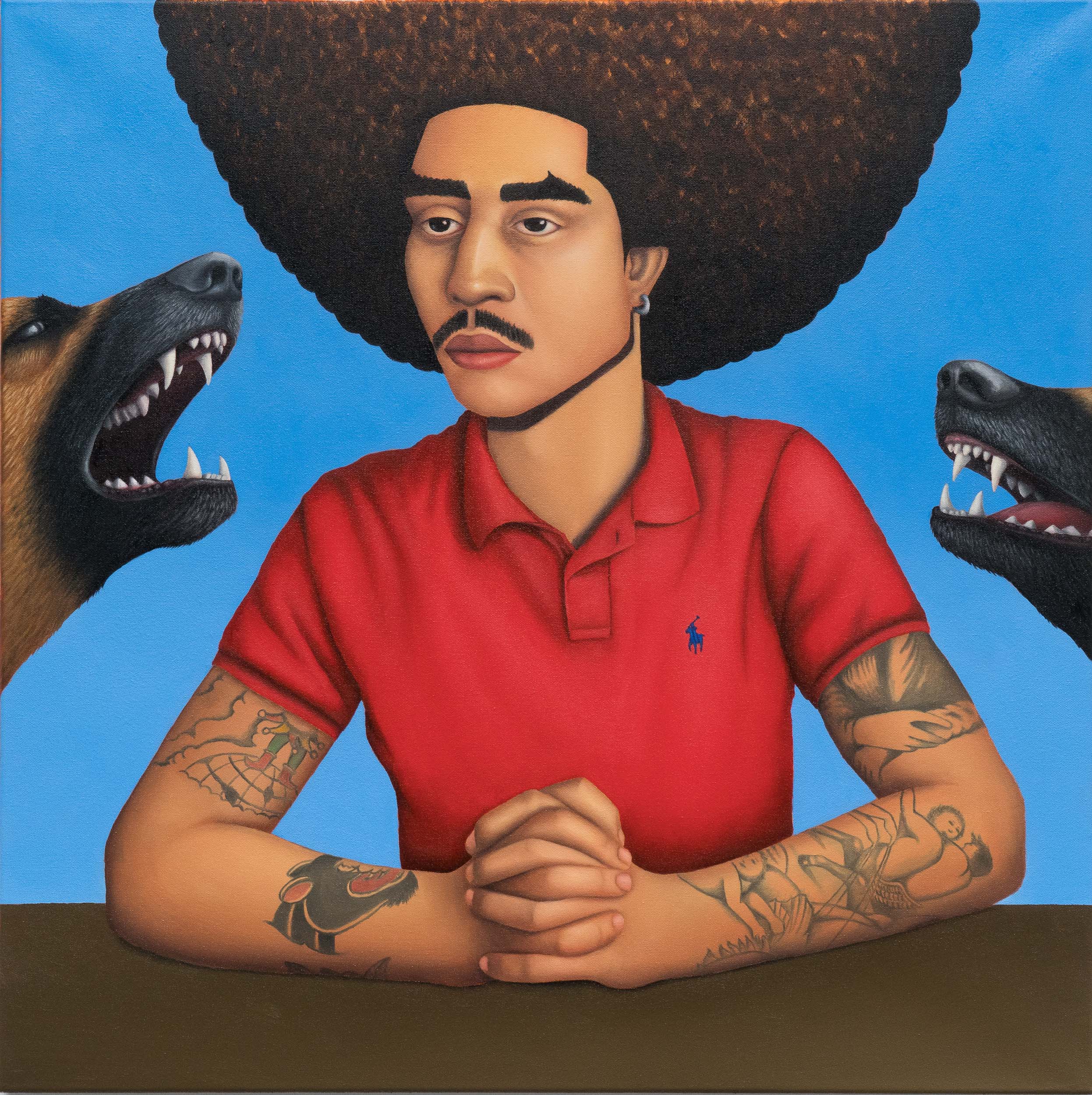
Jake Troyli
Sitting Duck, 2021
oil on canvas
30 x 30 in
Courtesy of the artist and Monique Meloche Gallery, Chicago
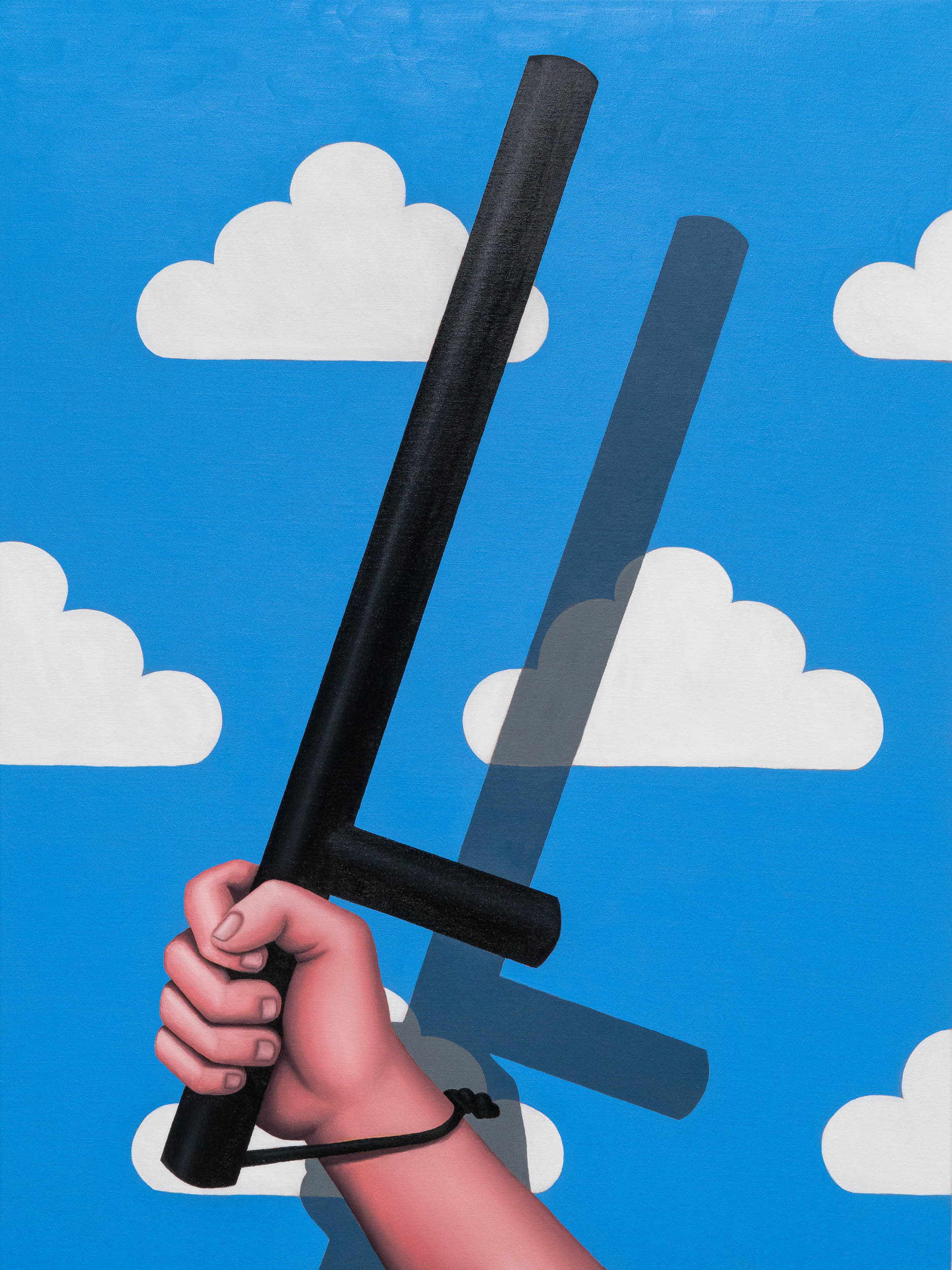
Jake Troyli
Untitled but only one call away, 2021
oil on canvas
40 x 30 in
Courtesy of the artist and Monique Meloche Gallery, Chicago
SOUTH SOUTH (SS): How do you like to describe your relationship with art? What drew you to paint as your medium of choice?
Jake Troyli (JT): It’s a little cliché, but art making has always just kind of been part of the fabric of my life. When I was younger my mom had these little refrigerator magnets, all different words and parts of speech so you could make little sentences, or leave messages for someone to find. I used to take the individual words and draw the image of whatever the word was around the magnet. So our fridge was covered in little drawings of broccoli or blimps or sharks or whatever. I would just camp out and do that sh*t. I guess I’ve always been visually expressive, like I just innately always wanted an idea to be represented tangibly as a thing, something with substance. And then the fridge drawings just turned into constant drawing, doodling, creating these little characters I would give backstory to and make up personalities for. The drawings got sharper and sharper over time, at one point in sixth grade I even had a little business going at school, where I would draw little porno comics and sell them for $5 each. In terms of painting, though, I didn’t really start until like 2013 or so, as I was finishing undergrad, and I immediately fell in love. I think the attraction to paint came from the ability to create something colorful, something visually rich. I’m really excited by the idea of creating an image that’s immediately visually seductive, something that garners a really strong visceral response, and entices the viewer to really sit with it for a while and work through it. I’m always excited when work can create a response that’s complex, and in my case I think the tension between the image and the subject matter can create that complexity.
I’m always excited when work
can create a response that’s complex,
and in my case I think the tension
between the image and the subject matter can create that complexity.
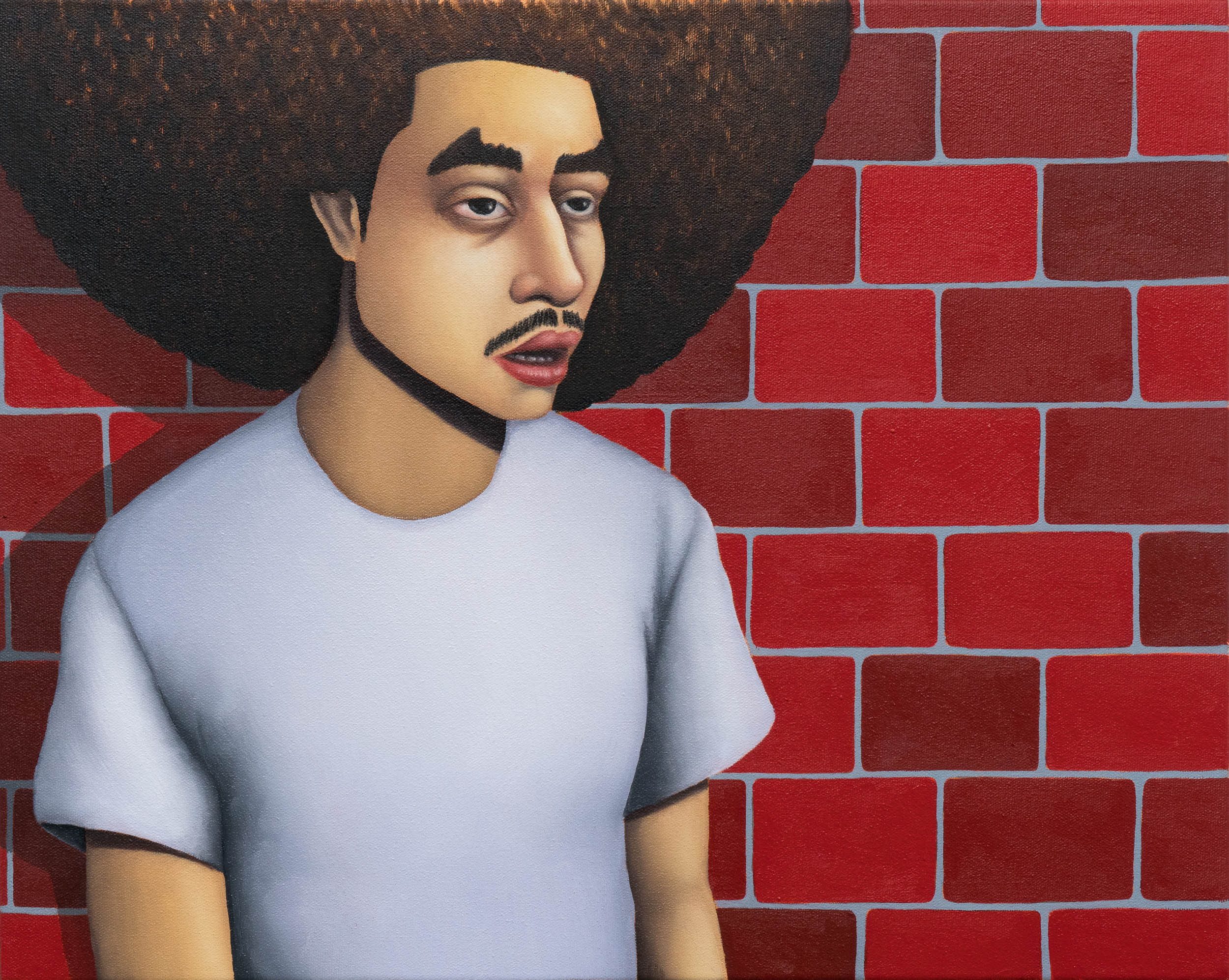
Jake Troyli
Clean Slate, 2021
oil on canvas
16 x 20 in
Courtesy of the artist and Monique Meloche Gallery, Chicago
SS: Is there a description of your work that you find most fitting?
JT: My work deals with (mis)representation, performance, otherness, and the construction of identity. By using my own form as a sort of elastic avatar, and appropriating motifs from both the classical and the comic, the paintings exist in a space that defies and subverts immediate assumption. Instead, I hope to recast uncomfortable truths with an appetizing palette, utilizing what I think of as self-conscious self-imagery and familiar language to navigate tense conversations with my viewer, and with myself.
SS: Who/what have been important influences in your overall work process and current understanding of your practice?
JT: Well my mom was definitely the most consistent influence I had, in her support but also in what she exposed me to. That kind of early support system can’t be understated. I mean, you’re talking about a single black mother raising a son who was 6’9 and athletic. While the rest of the world seemed absolutely positive that my only career option was the NBA, she always encouraged my being an artist. I remember pretty early on (probably slightly before she should have) she bought me a subscription to MAD magazine for my birthday. I had already been fascinated by and really attracted to comics, like The Far Side, Calvin and Hobbes, things like that, and then MAD took it to the next level. The artists were so technically good, so clear in their vision, and balanced real social commentary with humor so expertly. I was obsessed, and it’s clearly become such an important cornerstone in my visual language that the credit has to be given. That was huge. Later I started being really intrigued by the work that came out of the Northern Renaissance, the strangeness of the figures and their anatomy, the stiffness of the poses of the subjects seated in front of their idyllic backdrops. There was a sort of performative aspect to it all, which of course I was drawn to as I was starting to navigate my ongoing internal dialogue regarding the spectacle/spectator relationship. In my first semester review of grad school one of the most important suggestions came when it was suggested that I go to NY to see Kerry James Marshall’s Mastry show at the Met Breuer. I had no idea who KJM even was at the time. I went, and that was definitely a pivotal moment for me, as it totally shifted my idea of what was possible to achieve through painting.
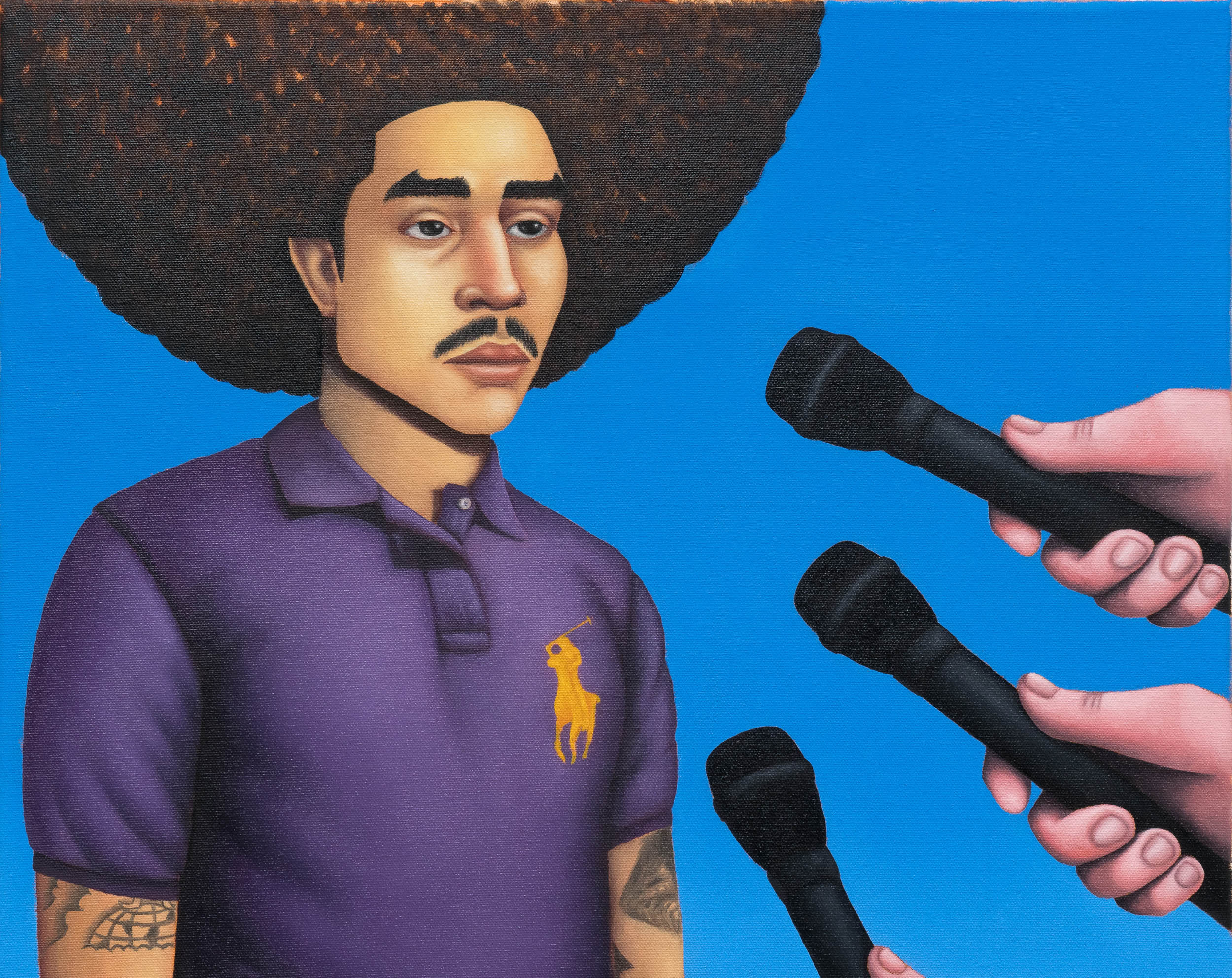
Jake Troyli
Hot Mics, 2021
oil on canvas
16 x 20 in
Courtesy of the artist and Monique Meloche Gallery, Chicago
SS: The idea of looking and being looked at seems to be quite prominent in how you conceptualise your work. What is guiding your impulse to explore this thematically?
JT: Right now I’m thinking a lot about performance, visibility, voyeurism and what it means to be on display. The relationship between the audience and the performer is an interesting and really complex dynamic that I’m constantly reflecting on and working through. I played D1 basketball in college, and in hindsight I think that was when I was first starting to get critical about the idea of the spectacle, of my own form and abilities as commodities that people were eager to consume. So I play with the subtle divide between subject and object, and how quickly and easily that line can blur.
SS: Who do you see as your audience and who do you see as your community? Are they the same people? Are they an important consideration in the making of your art, particularly when thinking about the topics you are exploring in your work?
This is such a great question. I consider this often. First and foremost, I want my work to be accessible. I talked about MAD magazine and my relationship with comics earlier. That was where my understanding of art making was rooted. I wasn’t brought up in what you would call the art world. I had no real idea of what the contemporary art world was or even what “contemporary art” encompassed until grad school. So for me, I developed a community long before I started to form an audience through my practice. I want my community to be a part of my audience, but I also don’t want to just speak to them exclusively. I think that also ties into my handling of paint and the usage of humor. I’m working through serious and complex issues but on the surface there’s a really graphic and supple image sort of beckoning you to go deeper. That’s the first access point, I think. Starting with an image that’s appealing to the eye, regardless of whether that eye is trained or untrained.
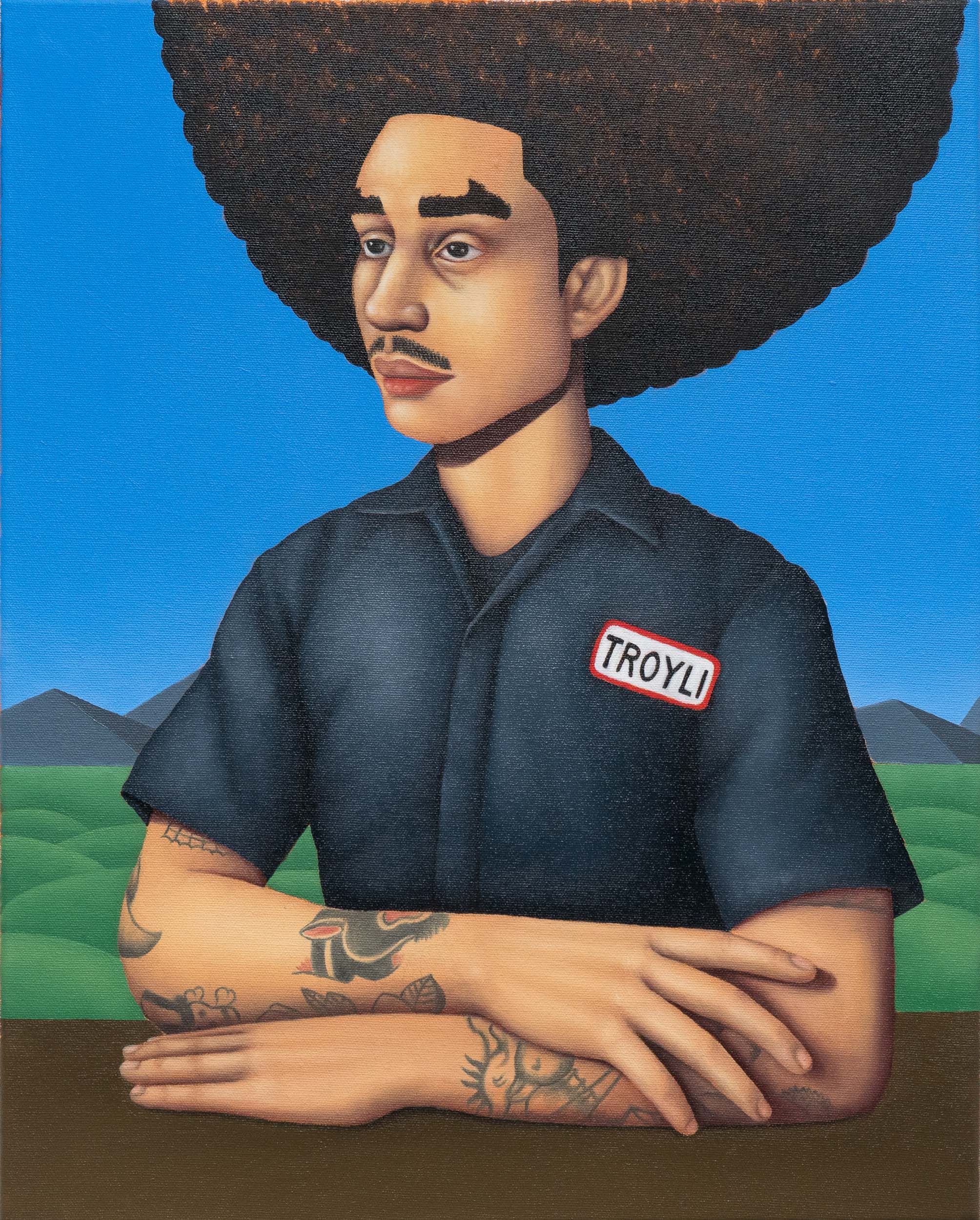
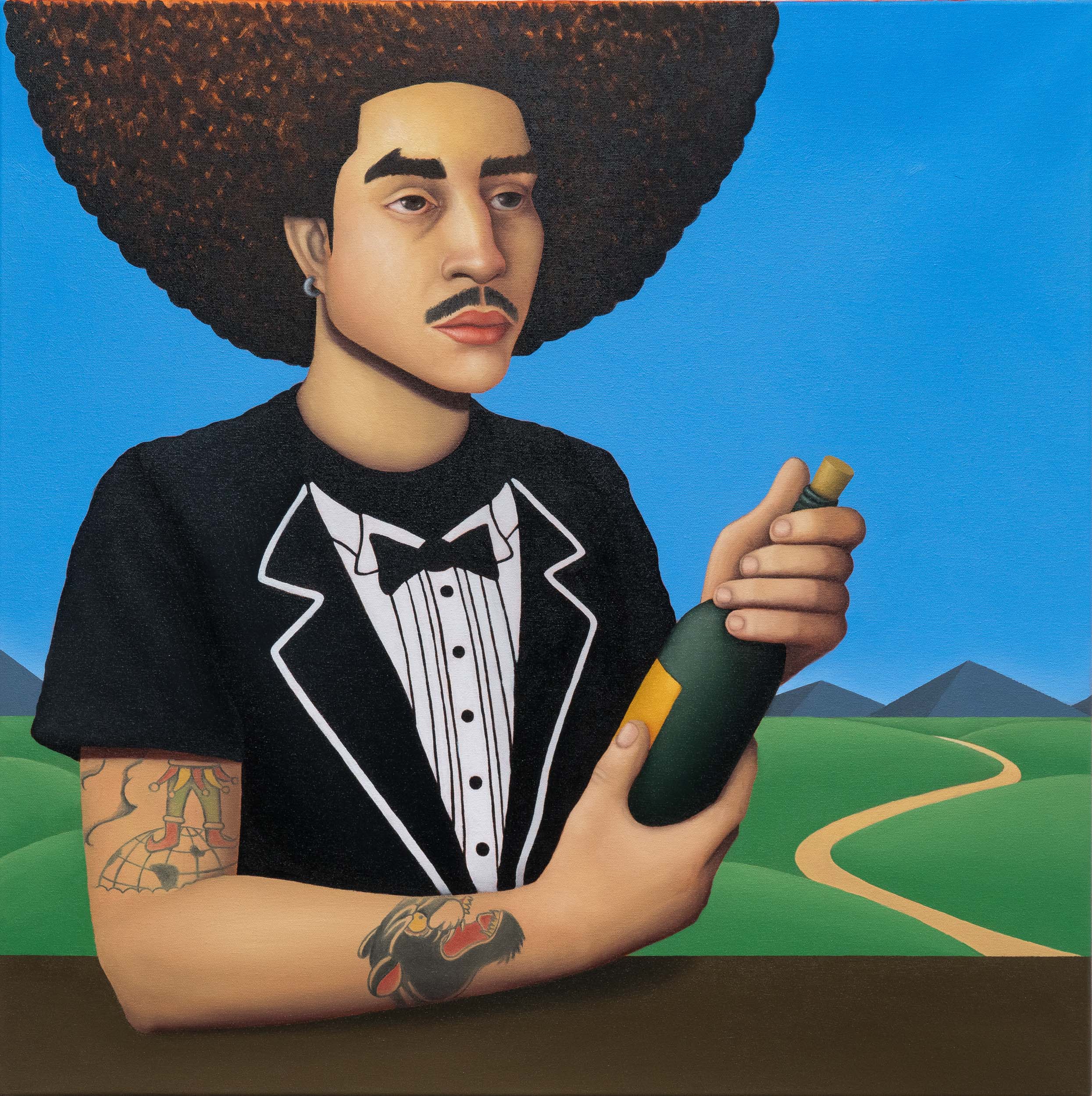
Top: Jake Troyli, Self-portrait on break, Oil on canvas, 2021. Courtesy of the artist and Monique Meloche Gallery, Chicago
Bottom: Jake Troyli, Celebration Preparation I, Oil on canvas, 2021. Courtesy of the artist and Monique Meloche Gallery, Chicago
SS: How do you hope to position yourself within your immediate arts ecosystem?
JT: Well I just moved to Chicago in September 2020. I got my studio first, and got to work. Obviously during COVID times it’s been difficult to really get rooted in the city, because the social aspect of everything has been so limited. So right now, I’m just excited to start seeing people regularly again, and have the opportunity to really get to know the super talented artists and organizers out here.
SS: Your use of colour is incredibly dynamic, as well as your application of paint to create beautifully smooth surfaces and relatively simplistic backgrounds. I particularly enjoy your portraits, perhaps because they come together in my mind as Drake’s Nothing Was the Same album cover crossed with poses from classical portraiture. Could you perhaps share more on your approach to portraiture? And how your use of paint helps you achieve this?
JT: Thank you! I love that reference. Like I mentioned earlier I’m really interested in Northern Renaissance portraiture, the strange stiffness of it all, and I think that is especially powerful when you start to consider the subject as being on display, as I do. So there’s this really intriguing dynamic that can exist between the viewer and the figure, this 1-to-1 relationship that borders on voyeurism, that I’m always considering. My mom was an actor, so I grew up around community theater. It’s interesting to look at these periods of life in hindsight, because that was such a clearly important and influential time for me. Community theater companies don’t have any kind of budget, so I started to think a lot about bad set design, and the idea of the backdrop as a semi-convincing construct. So a lot of times when I’m considering my backgrounds I’m thinking of them as backdrops, flattened illusions of dimension like what they put behind you for school picture day. And the question I like to ask myself is whether or not the subjects are aware that they’re being observed, are they aware that they’re playing a part, or have they also been convinced by the construct?
SS: You recently produced a new body of work that was shared during SOUTH SOUTH VEZA. How do these works fit into your larger exploratory thoughts and processes?
JT: I just had my first solo show “Don’t Forget to Pack a Lunch!” with Monique Meloche Gallery in September. I’m thinking of this body of work for South South as a continuation of that work, while kind of pushing some of my newer thoughts and explorations. I think of my own form as what I refer to as an elastic avatar, one that I can manipulate and stretch, and I’ve started becoming more and more interested in the actual stretching of the form. I mentioned earlier the very thin divide between subject and object. How can I contort my figures like objects to fit the compositions, how can I stretch and squeeze them into increasingly strange shapes, poses and positions. I consider code-switching to be a kind of self-contortion, a way to squeeze into a form that best fits the scenario, so I’m really excited about starting to push that in the literal sense with my figures.
SS: Following on from the previous question, is there any particular work you have produced you feel most connected to or view as an anchor point for how you thought through this body of work?
Definitely. When I consider a body of work, there’s always a central painting that the rest of the work orbits around, referencing or being contextualized by. In my last show, it was the titular piece Don’t forget to pack a lunch! from which I pulled out vignettes that became finished works. I feel as though this series of paintings for SOUTH SOUTH VEZA is a continuation of those thoughts, with paintings that still exist within that orbit. But I also like to think of a body of work as one work when it’s viewed all together, like all the pieces contextualize and pull from each other. Developing narrative has always been really important to me.
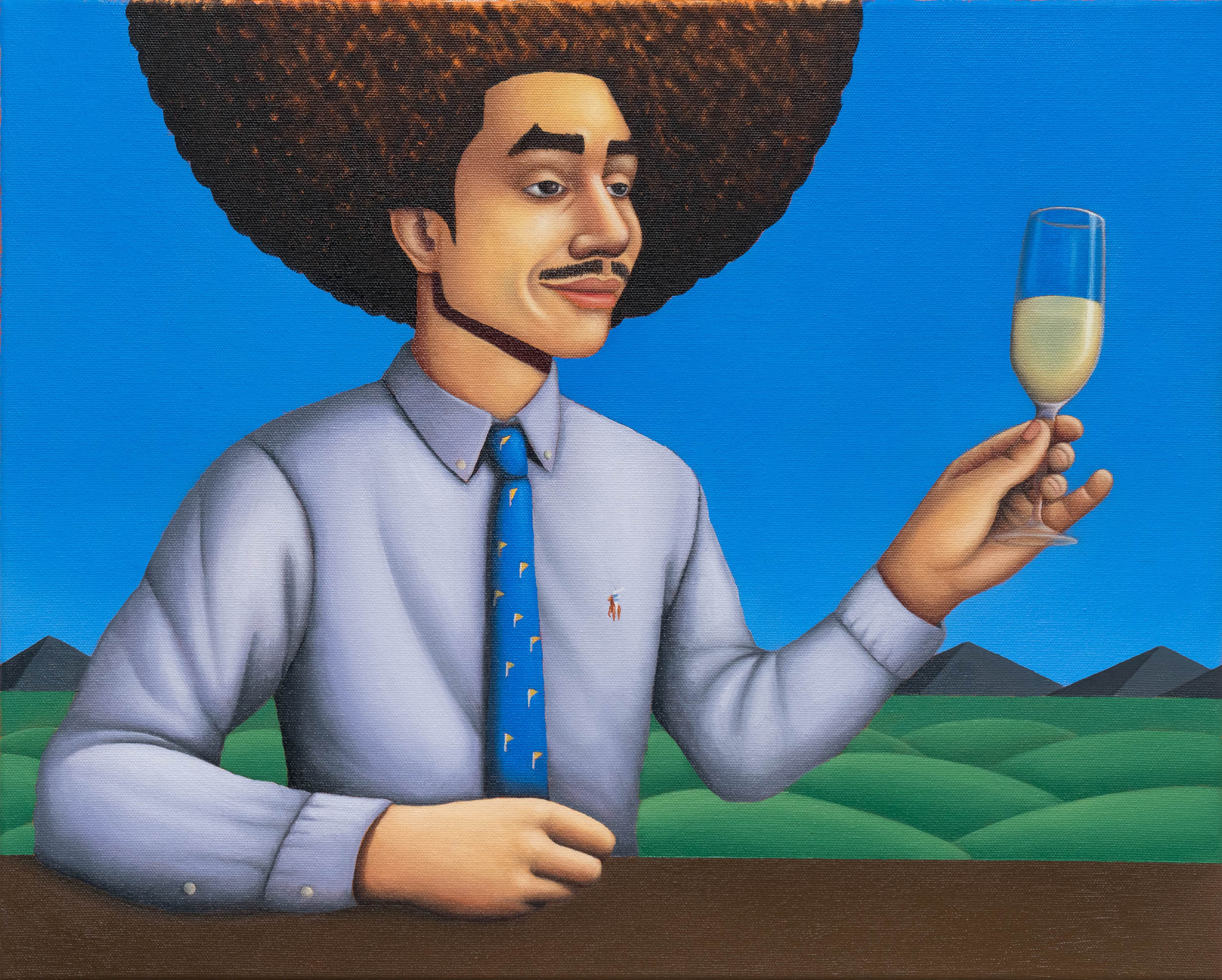
Jake Troyli
May I have your attention please?, 2021
oil on canvas
16 x 20 in
Courtesy of the artist and Monique Meloche Gallery, Chicago
SS: What are you most excited by at the moment?
Whenever I work through a new series of paintings, while I work I start sort of figuring out new ideas, new vignettes for future pieces. They come in flashes, and I try to scramble to write them down as they come so I don’t lose them. Now that I’ve finished this collection, I’m ready to start taking those abstract ideas and stitching them together. So that’s what is really exciting me right now. I’m going to take some time to gather these thoughts and then I’m going to get started on my next large-scale piece. Nothing is ever more exciting than the next thing, right?
Jake Troyli in conversation with Curator Larry Ossei-Mensah as part of the SOUTH SOUTH VEZA Gallery Programme
CREDITS
All images courtesy of the artist and Monique Meloche Gallery, Chicago, IL.
‘Don’t Forget to Pack a Lunch!’ digital catalogue – Jake Troyli’s first solo exhibition with Monique Meloche in Fall 2020.
